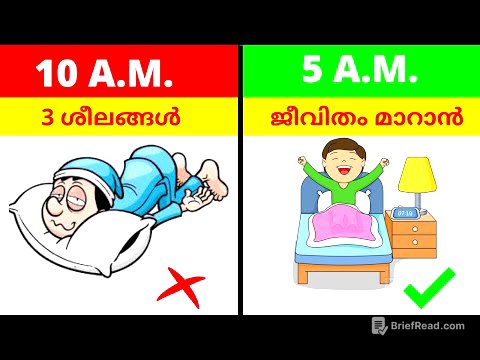TLDR;
This video provides a comprehensive guide to prompt engineering, sharing insights and practical tips. It emphasizes the importance of using playground models over consumer models, optimizing prompt length, understanding prompt types, and using unambiguous language. The video also covers advanced techniques such as one-shot prompting, defining output formats, and iterating prompts with data.
- Use playground models instead of consumer models for better control.
- Optimize prompt length to improve model performance.
- Understand and utilize system, user, and assistant prompt types.
- Use unambiguous language to guide the AI effectively.
Introduction to Prompt Engineering [0:00]
Nick Saraev shares his extensive experience in prompt engineering, gained from building successful service and consulting businesses since 2019. The video aims to provide a comprehensive overview of prompt engineering, covering both foundational concepts and actionable advice for beginners. The goal is to share all the knowledge in a concise and practical manner.
Transitioning from Consumer to Playground Models [0:16]
The video emphasizes the importance of using playground or workbench models instead of consumer models like ChatGPT or Claude. Consumer models have built-in optimizations that limit control over the AI's behavior. Playground models, such as the OpenAI API playground, offer more manipulation options, including selecting model types, response formats, and configuring parameters like temperature and max tokens. Using playground models allows for more precise engineering of prompts.
Optimizing Prompt Length for Better Performance [1:52]
Model performance decreases as prompt length increases. Shortening prompts can improve output quality. While providing examples and context is beneficial, it's crucial to improve the information density of instructions. A graph illustrates how accuracy decreases with longer input text across various models.
Simplifying Your Prompts [4:59]
The video demonstrates how to simplify a verbose prompt to improve its effectiveness. By removing unnecessary words and phrases, the prompt becomes shorter and more focused. This process involves identifying and eliminating fluff while retaining the core message. The example shows reducing a 674-word prompt to a more concise version, improving accuracy by approximately 5%.
Understanding Prompt Types [11:32]
There are three main prompt types: system, user, and assistant. The system prompt defines how the model identifies itself, providing general instructions. The user prompt tells the model what to do. The assistant prompt includes the model's output, which can be used as an example for future outputs. Understanding how these prompts work together is crucial for developing effective prompts.
Utilizing One and Few Shot Prompting [15:41]
One-shot and few-shot prompting involve including examples in the prompt to guide the model. Studies show that including just one example can significantly improve accuracy. The difference in accuracy between zero-shot and one-shot prompting is greater than the difference between one-shot and few-shot prompting. Using one example can provide a massive improvement in accuracy while keeping the prompt short.
Conversational Engines vs Knowledge Engines [19:20]
LLMs like ChatGPT are conversational engines, not knowledge engines. They excel at reasoning and conversation but may not provide accurate facts. Knowledge engines, such as databases and encyclopedias, know facts but cannot converse. The best results come from connecting an LLM to a knowledge engine to query facts.
The Importance of Unambiguous Language [22:53]
Using unambiguous language is crucial because AI is creative and can produce different answers each time. Being specific and clear in prompts minimizes variability and ensures responses are closer to the desired output. For example, instead of asking to "produce a report," specify "list our five most popular products and write a one-paragraph description."
The Spartan Tone of Voice [26:24]
Using a "Spartan" tone of voice in prompts can improve results. The term "Spartan" implies directness and pragmatism, which helps guide the model effectively.
Iterating Prompts with Data [27:12]
Iterating prompts with data is essential for achieving the highest quality prompts. This involves testing prompts multiple times and making progressive changes based on the results. A Monte Carlo approach involves throwing a bunch of stuff at the wall and then progressively making changes to get it closer and closer to where you want. This can be done using a Google Sheet to track prompts, outputs, and whether the output is "good enough."
Defining Output Formats Clearly [32:34]
Clearly define the desired output format, such as a bulleted list, JSON, or CSV. Instead of asking to "produce a sheet about financial data," specify "generate a CSV with month, revenue, and profit headings based off of the below data." This ensures the output is structured as needed.
Avoiding Conflicting Instructions [35:21]
Avoid using conflicting instructions in prompts. For example, asking for a "detailed summary" is contradictory because a summary is inherently concise, while "detailed" implies complexity. Eliminating such conflicts reduces token length and improves clarity.
Learning Data Formats: XML, JSON, CSV [36:42]
Learn data formats like XML, JSON, and CSV to structure data effectively. XML uses tags to define elements, while JSON uses curly braces, quotes, and colons. CSV is a hyper-compressed format using commas as delimiters. While CSV is compact, LLMs may lose their sense of place in long CSV outputs, making XML and JSON more reliable for larger applications.
Key Prompt Structure for Success [42:23]
A key prompt structure includes context, instructions, output format, rules, and examples. Context provides background information, instructions outline the task, output format specifies the desired structure, rules provide guidelines, and examples demonstrate the expected output. This structure helps create effective and reliable prompts.
Generating Examples for AI [46:41]
Use AI to generate examples for training the model. Instead of manually finding examples, use a prompt to create similar training examples. This can save time and effort while still providing the model with valuable guidance.
Choosing the Right Model for the Task [48:37]
Choose the right model for the task. Simple models are cheaper, while complex models are more expensive. For most applications, using a smarter model is better because the token costs are relatively low. Smarter models can eliminate problems and provide better results.
Conclusion and Call to Action [51:57]
The video concludes by encouraging viewers to ask questions and suggest topics for future videos. It also promotes Maker School and Make Money with Make.com, communities for those starting or scaling automation businesses. The video encourages viewers to like, subscribe, and engage with the content.









